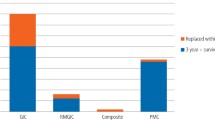Key Points
-
This study reports the views of GDPs and specialist paediatric dentists on how they would approach the care of young children presenting with a range of common clinical scenarios.
-
Large variation was found in the treatment choices for the scenarios within both generalists and specialists.
-
Different patterns in the approach to care were found when generalists and specialists were compared.
-
This variation is at odds with an evidence based approach to healthcare.
-
Randomised controlled trials are needed to identify the best way of treating young children with carious primary teeth.
Abstract
Aim To measure the distribution of choices for the treatment of a child with differing severities of caries in a primary molar tooth among specialists in paediatric dentistry and general dental practitioners (GDPs) in England.
Method Two surveys were undertaken using the same tool. The populations invited to take part in the study were confined to dentists practising in England in 2004. They were 500 GDPs selected at random from the list of all GDPs with a National Health Service (NHS) contract identified by the Dental Practice Board (DPB) and all 148 specialists in paediatric dentistry appearing on the General Dental Council specialist register. The selected dentists were sent a questionnaire containing four hypothetical clinical case scenarios in which the severity of dental caries in a single primary molar differed. Each clinical case scenario had a list of possible treatment options and participants were asked to select their single most preferred treatment option. To maximise the response rate there were three mailing rounds.
Results Of the 500 GDPs and 148 paediatric specialists sent a questionnaire, 322 (64%) GDPs and 115 (78%) specialists responded. The answers to each of the case scenarios indicate differences of opinion both between and among GDPs and specialists in the care they would recommend for a child with caries in a primary molar tooth. This variation in opinion about care was more pronounced for a single deep carious lesion than for a less severe lesion. The spread of treatment options chosen in each scenario indicates disagreement among GDPs and specialists about restorative techniques and philosophy of care.
Conclusion In England there is wide variation among GDPs and specialists in paediatric dentistry about the best way to treat a young child with caries in a primary molar tooth. Well designed studies are urgently needed to provide strong evidence for the most effective way to manage the dental care of children.
Similar content being viewed by others
Log in or create a free account to read this content
Gain free access to this article, as well as selected content from this journal and more on nature.com
or
References
Pitts N B, Boyles J, Nugent Z J, Thomas N, Pine C M . The dental caries experience of 5-year-old children in England and Wales (2003/4) and in Scotland (2002/3). Surveys co-ordinated by the British Association for the Study of Community Dentistry in 2001/2002. Community Dent Health 2005; 22: 46–56.
Fayle S A, Welbury R R, Roberts J F . British Society of Paediatric Dentistry: a policy document on management of caries in the primary dentition. Int J Paediatr Dent 2001; 11: 153–157.
Tickle M, Milsom K, King D, Kearney-Mitchell P, Blinkhorn A . The fate of the carious primary teeth of children who regularly attend the general dental service. Br Dent J 2002; 192: 219–223.
Levine R S, Pitts N B, Nugent Z J . The fate of 1,587 unrestored carious deciduous teeth: a retrospective general dental practice based study from northern England. Br Dent J 2002; 193: 99–103.
Milsom K M, Tickle M, King D . Does the dental profession know how to care for the primary dentition? Br Dent J 2003; 195: 301–303.
Pine C M, Harris R V, Burnside G, Merrett M C . An investigation of the relationship between untreated decayed teeth and dental sepsis in five-year-old children. Br Dent J 2006; 200: 45–47.
Tickle M . Improving the oral health of young children through an evidence-based approach. Community Dent Health 2006; 23: 2–4.
Duggal M . Providing children with the quality dental care they deserve. Community Dent Health 2006; 23: 66–68.
Threlfall A G, Pilkington L, Milsom K, Blinkhorn A S, Tickle M . General dental practitioners' views on the use of stainless steel crowns to restore primary molars. Br Dent J 2005; 199: 453–455.
Tickle M, Milsom K M, Blinkhorn A S, Worthington H V . Comparing different methods to detect and correct nonresponse bias in postal questionnaire studies. J Public Health Dent 2003; 63: 112–118.
Palmer N O, Martin M V, Pealing R, Ireland R S . Paediatric antibiotic prescribing by general dental practitioners in England. Int J Paediatr Dent 2001; 11: 242–248.
Dailey Y M, Martin M V . Are antibiotics being used appropriately for emergency dental treatment? Br Dent J 2001; 191: 391–393.
Watt R, McGlone P, Evans D et al. The facilitating factors and barriers influencing change in dental practice in a sample of English general dental practitioners. Br Dent J 2004; 197: 485–489.
Dental data digest search page. Dental Practice Board website. http://www.dpb.nhs.uk/gds/ddonline_digest_search.cfm
Milsom K M, Tickle M, Humphris G M, Blinkhorn A S . The relationship between anxiety and dental treatment experience in five-year-old children. Br Dent J 2003; 194: 503–506.
Scottish Intercollegiate Guidelines Network. Guideline 83. Prevention and management of dental decay in the pre-school child: a national clinical guideline. Edinburgh: Scottish Intercollegiate Guidelines Network, 2005. www.sign.ac.uk
Acknowledgements
This study was funded by the Wellcome Trust, grant code GD535 EDCX. The views expressed in the paper are solely those of the authors.
Author information
Authors and Affiliations
Corresponding author
Additional information
Refereed Paper
Rights and permissions
About this article
Cite this article
Tickle, M., Threlfall, A., Pilkington, L. et al. Approaches taken to the treatment of young children with carious primary teeth: a national cross-sectional survey of general dental practitioners and paediatric specialists in England. Br Dent J 203, E4 (2007). https://doi.org/10.1038/bdj.2007.570
Accepted:
Published:
Issue date:
DOI: https://doi.org/10.1038/bdj.2007.570
This article is cited by
-
Restorative thresholds for carious lesions in primary molars: French dentist’s decisions
European Archives of Paediatric Dentistry (2021)
-
Management of carious primary molars within the community dental setting in Wales: a retrospective observational study
British Dental Journal (2019)
-
Variation in caries treatment proposals among dentists in Norway: the best interest of the child
European Archives of Paediatric Dentistry (2017)
-
Undergraduates' self-reported clinical experience, confidence and perspectives of hospital and outreach paediatric dentistry: a three-year multi-centre evaluation
British Dental Journal (2014)
-
School-based epidemiological surveys and the impact of positive consent requirements
British Dental Journal (2008)



